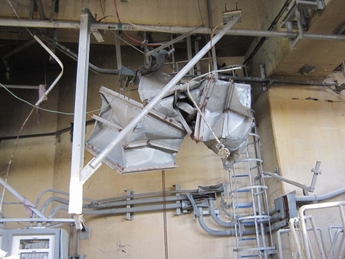TEPCO has launched a radiological decontamination system for the unit 2 spent fuel pool. TEPCO said that the system needed to start before a desalination system that is also planned, since highly radiological concentrated seawater is difficult to treat.

The system takes water from the circulating cooling system installed earlier this year (after the heat exchanger), and passes it through a truck-mounted valve unit, a truck-mounted caesium adsorption tower, and returns the water to the cooling system line before heat exchange. The system is truck-mounted to save space. It is expected to reduce the level of caesium by 100-1000 times.
TEPCO chose unit 2 because it has the highest radiological contamination level; 120,000 Bq/cc of caesium-134 and 110,000 Bq/cc of caesium-137. That level is about two-thirds higher than unit 3's spent fuel pool, and 5-10 times the levels of unit 1's, according to sampling data taken in August and September. The unit 4 spent fuel pool water had much lower radiation levels: 120 Bq/cc and 8.2 Bq/cc.
An investigation team has ventured into the unit 4 reactor building to gather evidence to determine the cause of the 15 March explosion in unit 4. The dominant hypothesis currently is that hydrogen generated in unit 3 flowed backwards up unit 4 air-conditioning ducts and flowed into the unit 4 reactor building. The team drew one firm conclusion: that the explosion likely occurred mainly on the fourth floor of the building, for two reasons: the fifth floor deck was pushed up and the third floor deck was pushed down, and because wire mesh attached to fifth floor air conditioning inlets were bent in the reverse direction of air flow. On the fourth floor itself, all of the air-conditioning ducts had been pulverised and scattered over the floor, suggesting that it was possible that the explosion occurred around them.
| JANTI report recommendations |
| 1. Power sources 2. Heat sinks (coolant injection and cooling) 3. Measures to protect against hydrogen explosion |




